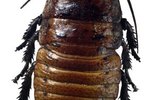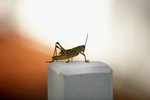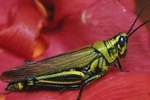
While many people love to hear crickets at night, they can also become pests in homes and among agricultural crops. Although omnivorous, crickets are more likely to munch on plants than other critters. Cricket species vary in color, size and habitat, but many share more than a few common characteristics. Crickets are closely related to grasshoppers and also share a few traits with members of this family.
Color
Most crickets encountered in the United States are yellow, brown or black; many have two or more colors that gradually fade into each other, such as brown into yellow or brown into black. Field crickets (Gryllus sp.) are very dark brown or black, whereas the similar house cricket (Acheta domesticus) is yellowish-brown with dark bands across the head and thorax. Cave and camel crickets (Gryllacrididae sp.) are yellow, tan or dark brown, although not as dark as field crickets. Jerusalem crickets (Stenopelmatus fuscus Haldeman) are yellowish with black, banded abdomens.
Legs
In general, crickets have long, powerful hind legs that help them jump. The hind legs are noticeably thicker and larger than their front legs. The mole cricket (Scapteriscus sp. and Neocurtilla sp.) has enlarged front legs that enable this species to dig. The mole cricket's back legs are also thick, like other crickets, although this species is a poor jumper. Many crickets possess sharp spines on their legs, as well; these spines are noticeable if you pick up a cricket because of their texture. Like many other insects, crickets also have their tympanum on the leg. The tympanum works like an ear and is a tightly stretched membrane that catches sound.
Additional Appendages
Most female crickets possess a very long egg-laying guide called an ovipositor. The ovipositor is ventrally attached at the rear and is sometimes as long or longer than the body. The tip of the ovipositor is rounded, much like the tip of a cotton swab. The antennnae of house and field crickets are also longer than the body and often curve backward past the rear. Most crickets fold their wings tightly over their backs; the mole cricket is quick to fly at night.
Habits
Field crickets must lay their eggs in the soil; house crickets are adapted to laying their eggs indoors where they occasionally become pests. Crickets go through a simple metamorphosis: egg, nymph, adult. Immature nymphs closely resemble their adult counterparts. Field crickets prefer to stay outside in moist environments; house crickets are common inside homes near fireplaces and furnaces. The odd-looking Jerusalem cricket spends most of its life underground, whereas the mole cricket spends most of its life at or just below the soil surface.
References
Photo Credits
-
Zedcor Wholly Owned/PhotoObjects.net/Getty Images
Writer Bio
With a professional background in gardening, landscapes, pests and natural ecosystems, Jasey Kelly has been sharing her knowledge through writing since 2009 and has served as an expert writer in these fields. Kelly's background also includes childcare, and animal rescue and care.




